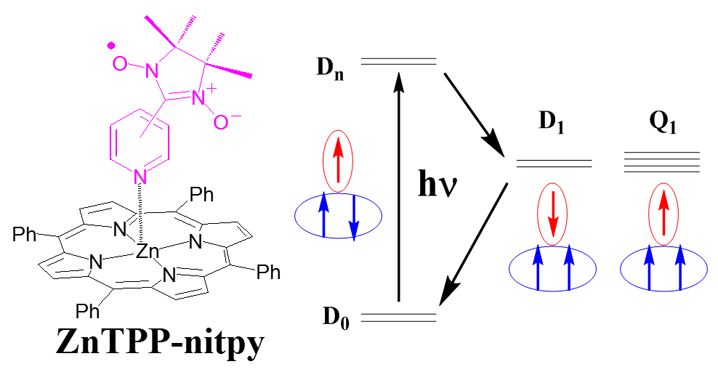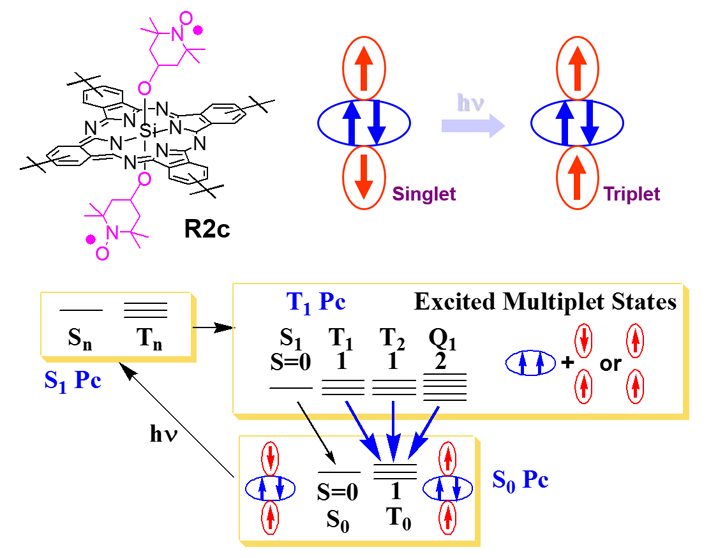Science of Excited Multiplet States
[1] Measurements and Analyses
Interactions between photoexcited triplet molecules and paramagnetic species result in some important phenomena, such as quenching of photoexcited molecules and generation of excited singlet oxygen, while the nature of these interactions have not been clear.
So far, there have been few studies on the chromophore bonded to stable radicals by using EPR (Electron paramagnetic resonance spectroscopy) or TREPR (Time-resolved electron paramagnetic resonance spectroscopy) together with such optical measurements.
When applying TREPR to the paramagnetic compound ZnTPP-nitpy, we succeeded for the first time in observing the doublet state D1 and quartet state Q1.
In addition, by establishing the simulation for Q1 TREPR spectra, we proposed a novel method to evaluate paramagnetic compounds.

[2] Photocontrol of Magnetic Properties
By selectively inactivating photoexcited multiplet states formed from two radical spins and the excited triplet spin of phthalocyanine, we discovered changes in the magnetic properties of ground states (In the figure, by the selective decays from the T1, T2 and Q1 states, the triplet ground state, T0, is preferably generated compared with the singlet ground state, S0).
This novel phenomenon in using photoexcited multiplet states is fundamentally different from the conventional concept of controlling magnetic properties. Herein, the transition from S0 to T0, which is impossible by thermal excitation, is controllable by photoexcitation at room temperature.
This study not only contributes to the elucidation of radical-chromophore interactions but also opens up a novel approach for controlling magnetic properties by photoexcitation.

Related Papers
-
G. I. Likhtenstein, K. Ishii, and S. Nakatsuji
Invited Review "Dualchromophore-Nitroxides: Novel Molecular Probes, Photochemical and Photophysical Models and Magnetic Materials"
Photochem. Photobiol., 83, 871 (2007). -
K.Ishii, T. Ishizaki, and N. Kobayashi
"Time-Resolved EPR Studies on Magnetic Interactions between Excited Triplet Tetraphenylporphinatozinc and Doublet Nitroxide Radical"
Appl. Magn. Reson., 23, 369 (2003). -
S. Takeuchi, K. Ishii, and N. Kobayashi
"Time-Resolved EPR, Fluorescence, and Transient Absorption Studies on Phthalocyaninatosilicon Covalently Linked to One or Two TEMPO Radicals"
Free Radical Biol. Med., 38, 920 (2005). -
K. Ishii, H. Itoya, H. Miwa, M. Fujitsuka, O. Ito, and N. Kobayashi
"Relationship between Symmetry of Porphyrinic π-Conjugated Systems and Singlet Oxygen (1Δg) Yields: Low-Symmetrical Tetraazaporphyrin Derivatives"
J. Am. Chem. Soc., 123, 702 (2001). -
K. Ishii,T. Ishizaki, and N. Kobayashi
"Relationship between the Excited Multiplet EPR and Phosphorescence Lifetime in the Excited Triplet Octaethylporphinatozinc Coordinated by One TEMPO Radical"
Chem. Lett., 482 (2001). -
K. Ishii, T. Ishizaki, and N. Kobayashi
"Conditions for Forming Excited Multiplet States: Magnetic Interactions between Excited Triplet (Phthalocyaninato)zinc and Doublet Nitroxide Radical"
J. Chem. Soc., Dalton Trans., 3227 (2001). -
K. Ishii, S. Takeuchi, and N. Kobayashi
"Relationship between Electron Spin Polarization, Electron Exchange Interaction, and Lifetime: The Excited Multiplet States of Phthalocyaninatosilicon Covalently Linked to One Nitroxide Radical"
J. Phys. Chem. A, 105, 6794 (2001). -
J. Fujisawa, K. Ishii, Y. Ohba, S. Yamauchi, M. Fuhs, and K. Mobius
"First Observation of the Excited Doublet State of a Radical-Triplet Pair in Solution: W-Band High-Field Time-Resolved Electron Paramagnetic Resonance Spectroscopy"
J. Phys. Chem. A, 103, 213 (1999). -
K. Ishii, Y. Hirose, and N. Kobayashi
"Electron Spin Polarizations of Phthalocyaninatosilicon Covalently Linked to One TEMPO Radical in the Excited Quartet and Doublet Ground States"
J. Phys. Chem. A, 103, 1986 (1999). -
K. Ishii, T. Ishizaki, and N. Kobayashi
"Experimental Evidence for a Selection Rule of Intersystem Crossing to the Excited Quartet States: Metallophthalocyanines Coordinated by 4-Amino-TEMPO"
J. Phys. Chem. A, 103, 6060 (1999). -
K. Ishii, Y. Hirose, and N. Kobayashi
"Selective Population from the Excited Multiplet States to the Triplet Ground State in a Phthalocyanine: A New Concept for Controlling Magnetic Properties by Photoexcitation"
J. Am. Chem. Soc., 120, 10551 (1998). -
K. Ishii, J. Fujisawa, A. Adachi, S. Yamauchi, and N. Kobayashi
"General Simulations of Excited Quartet Spectra with Electron-Spin Polarizations: The Excited Multiplet States of (Tetraphenylporphinato)zinc(II) Coordinated by p- or m-Pyridyl Nitronyl Nitroxides"
J. Am. Chem. Soc., 120, 3152 (1998). -
J. Fujisawa, K. Ishii, Y. Ohba, S. Yamauchi, M. Fuhs, and K. Mobius
"X- and W-Band Time-Resolved Electron Paramagnetic Resonance Studies on Radical-Excited Triplet Pairs between Metalloporphyrins and Axial-Ligating Nitroxide Radicals"
J. Phys. Chem. A, 101, 5869 (1997). -
K. Ishii, J. Fujisawa, Y. Ohba, and S. Yamauchi
"A Time-Resolved Electron Paramagnetic Resonance Study on the Excited States of Tetraphenylporphinatozinc(II) Coordinated by p-Pyridyl Nitronyl Nitroxide"
J. Am. Chem. Soc., 118, 13079 (1996).
